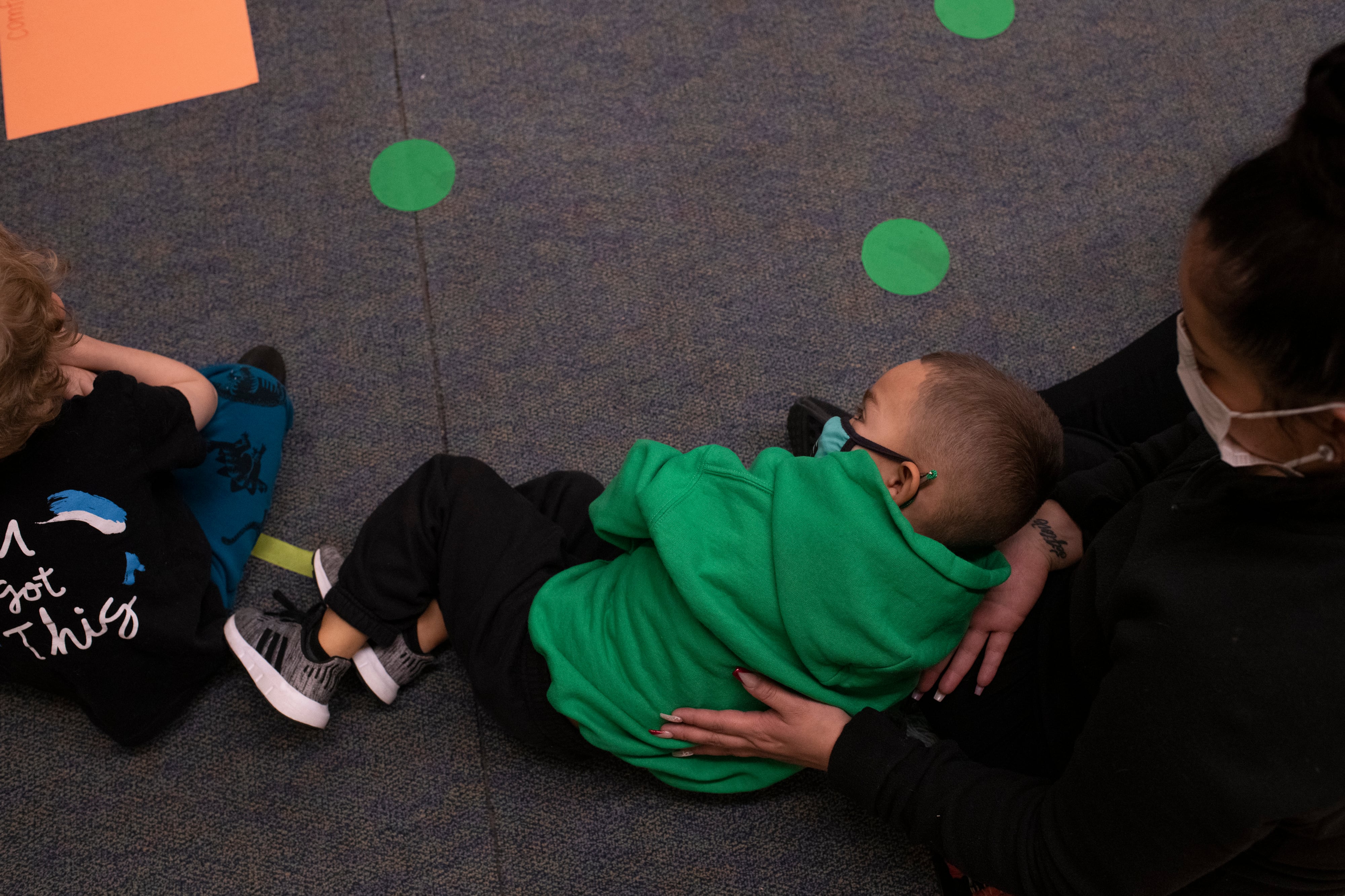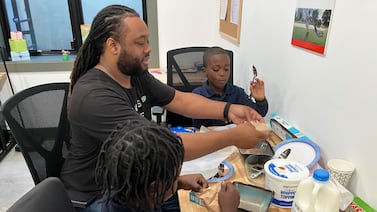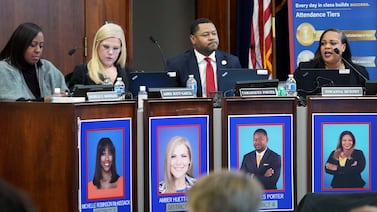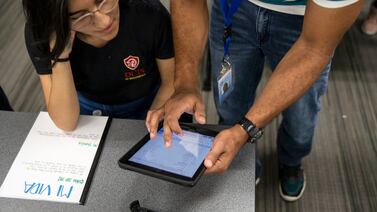The number of classroom assistants who provide extra support to students with disabilities in Chicago Public Schools has more than doubled in the past decade, according to district staffing data.
That growth has happened as the share of students with disabilities has also increased in CPS.
But the role and the ranks of these assistants is under scrutiny as the school district grapples with tighter budgets and is locked in a labor dispute that advocates worry could lead to worse services and care for children with the highest needs.
The labor dispute — between Service Employees International Union Local 73 and Chicago Teachers Union — is over a CTU proposal to allow the teacher assistants that union represents to be assigned to provide additional support to students with disabilities, a role historically represented by SEIU. The number of special education classroom assistants, or SECAs, represented by SEIU have grown in the past five years, while the number of teacher assistants, or TAs, represented by the CTU has dropped in the past decade.
On average, SECAs make slightly more than teacher assistants. For example, this school year, SECAs without a degree are making an average $48,338 — about $3,700 more than teachers assistants at a similar level, according to district data.
Mary Fahey Hughes, a former member of the Chicago Board of Education and longtime advocate of students with disabilities, said the SECAs who worked with her son Aidan were critical to his development as a student with autism in CPS. People become SECAs specifically to work with students with disabilities and gain specific experience and training along the way in working with high-needs students, she said.
“I understand that it must be awful to be a teachers assistant and to have worked many years and to have your position no longer be needed, but I can’t get behind giving SECA jobs to TAs,” Hughes said.
The CTU — traditionally a close ally of the SEIU — said its proposal is meant to boost the number of teacher assistants and provide more options of support for students with disabilities, in a district that has historically struggled to serve those kids. In 2018, the state found that the district was systemically failing to provide students with disabilities with the extra services they are legally entitled to and placed it on a corrective action plan.
Over the past few years, SEIU has fought to create guardrails on the job duties of SECAs and expand training for the position. The SEIU has characterized CTU’s proposal as “a raid” on its membership and said it would hurt the quality of services provided to students with disabilities.
SEIU has threatened to sue the district even though CPS has so far rejected the CTU proposal. SEIU’s parent union also passed a resolution earlier this month declaring that it was “under attack” by the CTU. The division between the two labor unions could come with political fallout for Mayor Brandon Johnson, who won election in 2023 with both financial and boots-on-the-ground help from both groups.
Who are SECAs and TAs?
Assistants can provide a range of needed extra help in classrooms and their exact job title may not be obvious to students and families. But their roles are distinct.
SECAs provide extra support to students with disabilities and their roles are written into legal documents governing the services those children are entitled to under federal law. Teacher assistants provide a range of additional support in the classroom and historically, the district budgets for them to support specific programs, such as pre-K or reducing class size, or principals hire them using discretionary funds.
SECAs “assist in the instruction, behavioral, and personal care needs” of students with disabilities, according to SEIU’s contract. That can mean helping them with a lesson in class, walking them to the bathroom, and helping them calm down by taking a walk in the hall, but can also include feeding and assisting them in using the bathroom, educators told Chalkbeat.
“I mean, whatever is needed for them to be safe and get their instruction,” said Kimberly Weston-Dodd, a longtime SECA at Corliss High School and SEIU delegate.
A student with a disability typically has one of two documents that outline the additional services or accommodations they’re legally entitled to: an Individualized Education Program, or IEP, or a 504 plan. A child’s IEP team, which includes a parent and other school staff, determines if the child should receive extra support from a SECA. Based on that information, CPS’s central office decides how many SECAs to allocate for each school, and then principals hire them.
Teacher assistants, in contrast, can provide a range of additional support to teachers, such as putting up bulletin boards or redirecting a student if they get off task.
Thad Goodchild, deputy general counsel for the CTU, said schools have also, at times, used teacher assistants to provide additional support to students with disabilities.
SECA jobs have ballooned over the past decade while teacher assistant jobs have dropped, but the reasons why aren’t completely clear.
A decade ago, the district had just over 3,000 SECA positions with just over 200 of them unfilled. Since Dec. 31, 2019, the number of SECA positions has grown by 65%, with roughly 7,600 positions as of Dec. 31, 2024. Of those jobs, 325 were unfilled, according to district data.
At the same time, the district has opened 225 fewer CTU-protected teacher assistant positions, or about 18% fewer of those jobs than existed right before the COVID-19 pandemic.
Asked why SECA positions have increased while teacher assistant jobs have dropped, district spokesperson Sylvia Barragan said “the staffing structure has been adjusted to accommodate” the increase in students with additional needs. District officials also said that they used some of the $2.8 billion it received in federal COVID relief dollars to hire more SECAs after identifying that as one of CPS’s “pressing needs.”
Since the 2019-20 school year, the number of students with disabilities has grown by about 5%, according to district data. Still, the number of SECA positions grew by a far greater rate: 65% in that same time period.
But that massive increase happened after the state found that the district was systemically failing to provide students with disabilities with the extra services they are legally entitled to, advocates and union officials told Chalkbeat. As a result, the state placed CPS on a corrective action plan. Lindsay Record, a spokesperson for the Illinois State Board of Education, said hiring more SECAs was not part of that corrective plan, which has since been closed.
But before the state’s investigation, many children who needed SECAs weren’t getting them, said Terri Smith-Roback, a parent of a CPS student with a disability and longtime advocate who was part of a coalition that helped spark the state’s investigation. There was also “onerous,” time-consuming paperwork required at the time to get additional help for students with disabilities, said Smith-Roback. Those issues were highlighted in the state investigation.
“I think once the inquiry ended, people were able to assign SECAs to IEPs with more professional discretion and less red tape,” Smith-Roback said.
One elementary school principal, who spoke on condition of anonymity, said he’s noticed the changing culture around IEPs. He said IEP teams are asking for SECAs “much more liberally” than they did 10 to 20 years ago. The number of SECAs at his school — where enrollment has grown — have more than quadrupled over the past decade.
Union dispute started last summer
The dispute between the two unions became public in December when the Chicago Tribune reported that SEIU was planning to sue CTU. But the roots of it reach back to at least last summer.
Last summer, CPS laid off 240 teacher assistants and roughly 260 SECAs, offering to continue paying both pools of workers for this entire school year as they searched for jobs in other schools, according to officials at both unions. Of the teacher assistants, as many as 140 have landed jobs at other schools — but a “significant number” of them have been rehired as SECAs at the same school, according to Goodchild, the CTU lawyer.
Around that time last summer, CTU leaders asked SEIU leadership if SEIU would give CTU hundreds of vacancies that existed for SECA positions, in order to prevent teacher assistant layoffs, said Dian Palmer, president of SEIU Local 73. When vacancies exist, laid-off workers can search for jobs at other schools.
Goodchild said the union worried about more teacher assistants, many of whom have supported students with disabilities at some point, losing work. CTU didn’t want layoffs to “have any negative impact on either union,” he said.
Palmer said she wanted to help CTU, but realized that sharing those vacancies could mean less layoff protection for her own members — the SECAs. So she declined CTU’s request.
On July 17, 2024, CTU filed a grievance with CPS that claimed that the district has been converting teacher assistant jobs into SECAs for years in violation of its contract. It suggested that SECAs should only support students who also require diapering and toileting help, and that all other teacher assistant jobs that were converted into SECA jobs be reverted back to teacher assistants.
“The vast majority of the students are not toileted and fed, so if that’s the criteria, we know our [SECA] numbers would go way down,” Palmer said.
The grievance also demanded that the district’s Office for Students with Disabilities not assign SECAs to teacher assistant jobs that don’t have diapering and feeding duties. The union’s contract says the district cannot “reclassify” a teachers assistant as a SECA who does not diaper and feed a child.
Chicago Public Schools declined to comment on the grievance. SEIU viewed the grievance as a power grab by CTU and an insult to suggest SECAs have no value beyond bathroom and feeding responsibilities.
Then, in the fall, as CTU bargained with CPS over its new contract, SEIU became aware of a proposal from CTU that would allow principals to choose between SECAs and teacher assistants to support students with disabilities. That raised more alarm bells for SEIU: Giving principals a choice means they could choose teacher assistants, who can also do other work around the classroom, and could mean fewer SECAs in schools, Palmer said.
Goodchild said that “of course part of the goal is to increase the number of teacher assistants” because the decrease in teacher assistants “has had damaging impacts for students and schools and educators.”
What does it look like on the ground?
While SECA roles are more defined on paper, their roles inside schools can be more complicated, according to two elementary school principals who spoke to Chalkbeat.
One principal said she never approaches her teacher assistants to help with personal care needs that only SECAs can do. But her SECAs, like her teacher assistants, are “very willing in a pinch to step in” and help with additional needs, which come up a lot in schools. SEIU’s contract allows SECAs to help in emergency situations.
The other principal said while a quarter of his SECAs provide one-on-one support to students with disabilities, others are working with multiple students, helping to manage behavioral issues or helping them with a lesson. As student needs and enrollment changes during the year, he vacillates between feeling like he doesn’t have enough SECAs and feeling like he may have too many.
The expansion of classroom aides is among the overall growth in staff at CPS in the past five years. District officials continue to tout more than 7,000 positions added at a time of declining enrollment. But much of that has been possible because of federal COVID relief money, which is now gone.
While CPS officials say it’s a priority to keep the new positions, budget cuts could be looming. Adding more teacher assistants could help reduce class size and provide more support in schools, principals have said.
Both teachers assistants and SECAs need the same state paraprofessional license in order to work at CPS, which requires at least an associate degree, 60 semester hours of college credit, or a high school degree along with certain passing scores on either a state-approved paraprofessional exam or the ACT WorkKeys Career Assessment.
SEIU’s contract says SECAs with 60 semester hours of college credit must have taken courses in severe disabilities. If SECA candidates decide instead to take the state-approved exam, they must have worked with children with disabilities for at least one year.
The experience SECAs have and the additional training they’ll receive is important for properly serving students with disabilities, advocates and a principal told Chalkbeat. SEIU’s current contract requires CPS to provide SECAs with additional training on a range of issues, including generally working with students with disabilities, deescalation practices, and how IEPs work, starting this July.
“I don’t see the win for students in having a cohort of teaching assistants that don’t have the training, the certification, the desire to work with students with disabilities,” Hughes, the former board member, said.
Weston-Dodd, the SECA from Corliss, said SECAs like her have gained years of experience working exclusively with students with disabilities and are best positioned to serve those children. She also said she’s received professional development training annually.
Still, one of the elementary school principals believes that if she wanted teacher assistants to get similar training that SECAs will get, the district wouldn’t say no.
If CTU’s proposal is accepted by the district, advocates for students with disabilities, as well as SEIU, believe principals would have some incentive to choose teacher assistants since they have broader job responsibilities and are paid less.
“There’s a lot of needs in schools, and things happen and there are times when it’s, like, ‘I just need you to be the body here for a little bit,’” said one of the elementary school principals. “You have a lot more wiggle room with the teacher assistant job description than you do with a SECA job description.”
Still, that principal said she doesn’t want to make the decision on who should work with her highest need students.
The other principal believes it’s good that he doesn’t have undue influence on deciding what a student with a disability needs. But he feels that right now, “it’s arbitrary” on whether the person providing additional support to a child “has a TA job code or a SECA job code,” because their job would be to do what’s in a child’s IEP.
But, he said, he also believes that the person assigned to do the job should have better training.
Reema Amin is a reporter covering Chicago Public Schools. Contact Reema at ramin@chalkbeat.org.







